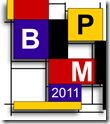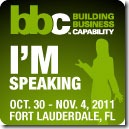I arrived in Boston yesterday for Progress Software’s user conference, Revolution, and to deliver an Introduction to BPM workshop yesterday afternoon. With that out of the way, I can focus on the other speakers here, and what’s happening with Progress these days.
The keynotes opened with Rick Reidy, the CEO, with a bit of history of Progress as a supporter of business-led software development, and their current leading position in helping companies to become more operationally responsive to external events. This seems a bit strange, given that it was announced six weeks ago that Reidy will be leaving as soon as a successor is found – what was the board thinking, allowing this to happen just prior to the user conference without a replacement in place?
Regardless of this elephant in the room, he spoke well about creating the responsive business as a revolution in both technology and business, and what Progress is doing to lead that with new versions of OpenEdge and RPM, the latter of which includes the Progress Control Tower, an interactive cockpit. In spite of Progress’ long history with their OpenEdge software development environment, it’s clear that much of their future success is based on the Apama CEP and Savvion BPM acquisitions, and the integration of these product functionalities into a comprehensive solution.
Next up was John Bates, CTO, talking about how business success is defined by how you respond to the continuous disruption that occurs in everyday business life. Looking just at stock trading – a favorite topic for Bates, who has done a lot of work in this area – consider flash crashes and events such as the recent UBS $2B loss due to a single rogue trader; but he also touched on the business responses to natural disasters such as the Japan earthquake earlier this year, where entire supply chains were reconfigured. On a smaller scale, consider business responses to customer events such as missed SLAs, complaints and even Twitter messages about your company or products. It’s not just disaster management/avoidance: there are also fleeting opportunities for revenue such as mobile promotions, web upsells, and algorithmic trading, which can’t rely on a person noticing that something needs to be done, but must be automated based on external events.
Bates pointed out that companies that use classic business intelligence are driving in the rear view mirror: using past data to try to predict the future. Instead, you need to become operationally responsive:
- Continuously mitigating risk
- Optimizing operations dynamically
- Capitalizing on real-time revenue opportunities
Progress has developed a responsive business prescription, which is a set of methods and tools for ensuring operational responsiveness. That starts with continuous business visibility, so that you can figure out how your business is doing in real time. That allows the next step, which is to sense and respond to opportunities and threats. Finally, you can improve your business processes based on this real-time sense and respond capability. See—Respond—Improve.
In order to do this, Progress provides an integrated suite of products that they call Responsive Process Management, which includes BPMS, CEP, business transaction management (BTM) and business analytics. The analysts are jumping on board: Gartner refers to this as intelligent business operations; IDC refers to it as business navigation systems.
BPM and CEP together are key to this: the BPMS allows for agile modeling and deployment of processes, while CEP correlates external events to determine what should impact the processes on the fly. He gave an example using the “tarmac rule” – the rule in the US that results in huge fines for airlines who load up a plane and leave the passengers sitting for more than 3 hours – where the combination of weather events, flight operations events, maintenance events and crew events can be used to avoid violating the tarmac rule by redeploying crew and aircraft as required, or avoid boarding a plane where it’s already known that the rule would be violated.
In order to become more responsive, business analytics have to combine real time and historical data, without necessarily replacing the core legacy systems that run the business. I touched on this yesterday during my workshop, in response to questions about the value of BPM when you have a perfectly good monolithic legacy application: basically, you want to gain visibility into (and potentially control) those legacy applications. This is where business transaction management comes into play, allowing you to monitor the events and state changes within the legacy applications, track and orchestrate the entire flow in BPM – for example, linking together CRM, ERP and logistics systems, plus adding new functionality in an end-to-end process flow – then use Control Tower to view and control the entire process, including the underlying legacy applications.
Bates is a great speaker (and a really smart guy), so it’s always a pleasure to see him present: equally informative and entertaining.
 He quoted Mike Gualtieri of Forrester, who said “Java is a dead-end for enterprise application development” earlier this year; Goodson pointed out that Java coding is not inherently agile enough for a truly responsive business as he announced OpenEdge 11: fully integrated with BPM, multi-tenanted and deployable in the cloud, with support for iPad and Silverlight. It appears that OpenEdge is now positioned as part of RPM, with OpenEdge BPM being positioned as “the world’s first business process-enabled application development platform”. Furthermore, it’s deployable in the cloud on their Arcade platform.
He quoted Mike Gualtieri of Forrester, who said “Java is a dead-end for enterprise application development” earlier this year; Goodson pointed out that Java coding is not inherently agile enough for a truly responsive business as he announced OpenEdge 11: fully integrated with BPM, multi-tenanted and deployable in the cloud, with support for iPad and Silverlight. It appears that OpenEdge is now positioned as part of RPM, with OpenEdge BPM being positioned as “the world’s first business process-enabled application development platform”. Furthermore, it’s deployable in the cloud on their Arcade platform.
 BPM 2011, the 9th annual academic research conference on BPM in Clermont-Ferrand. where I will be keynoting the industry track. I have attended this conference for the past few years and am hugely honored to be asked to keynote. I love this conference because it gives me a peek into the academic research going on in BPM – although I barely remember what an eigenvector is, I can always see some good ideas emerging here that will undoubtedly become some software vendor’s killer feature in a few years. This conference was in the US last year for the first time (it is usually in Europe, where a great deal of the research goes on) and I encouraged a lot of US BPM vendors to attend; hopefully, they will have seen the value in the conference and will get themselves on an international flight this time.
BPM 2011, the 9th annual academic research conference on BPM in Clermont-Ferrand. where I will be keynoting the industry track. I have attended this conference for the past few years and am hugely honored to be asked to keynote. I love this conference because it gives me a peek into the academic research going on in BPM – although I barely remember what an eigenvector is, I can always see some good ideas emerging here that will undoubtedly become some software vendor’s killer feature in a few years. This conference was in the US last year for the first time (it is usually in Europe, where a great deal of the research goes on) and I encouraged a lot of US BPM vendors to attend; hopefully, they will have seen the value in the conference and will get themselves on an international flight this time. Building Business Capability
Building Business Capability